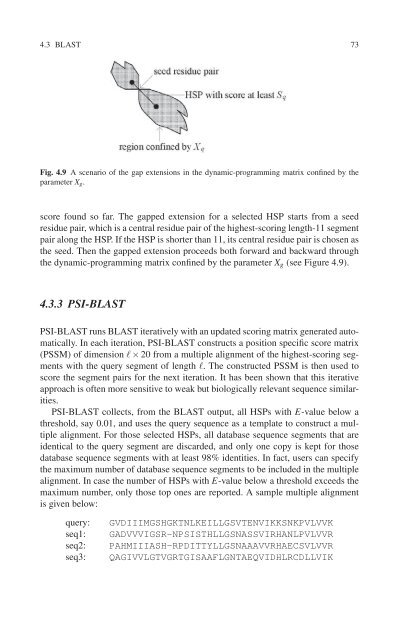Create successful ePaper yourself
Turn your PDF publications into a flip-book with our unique Google optimized e-Paper software.
4.3 BLAST 73<br />
Fig. 4.9 A scenario of the gap extensions in the dynamic-programming matrix confined by the<br />
parameter X g .<br />
score found so far. The gapped extension for a selected HSP starts from a seed<br />
residue pair, which is a central residue pair of the highest-scoring length-11 segment<br />
pair along the HSP. If the HSP is shorter than 11, its central residue pair is chosen as<br />
the seed. Then the gapped extension proceeds both forward and backward through<br />
the dynamic-programming matrix confined by the parameter X g (see Figure 4.9).<br />
4.3.3 PSI-BLAST<br />
PSI-BLAST runs BLAST iteratively with an updated scoring matrix generated automatically.<br />
In each iteration, PSI-BLAST constructs a position specific score matrix<br />
(PSSM) of dimension l × 20 from a multiple alignment of the highest-scoring segments<br />
with the query segment of length l. The constructed PSSM is then used to<br />
score the segment pairs for the next iteration. It has been shown that this iterative<br />
approach is often more sensitive to weak but biologically relevant sequence similarities.<br />
PSI-BLAST collects, from the BLAST output, all HSPs with E-value below a<br />
threshold, say 0.01, and uses the query sequence as a template to construct a multiple<br />
alignment. For those selected HSPs, all database sequence segments that are<br />
identical to the query segment are discarded, and only one copy is kept for those<br />
database sequence segments with at least 98% identities. In fact, users can specify<br />
the maximum number of database sequence segments to be included in the multiple<br />
alignment. In case the number of HSPs with E-value below a threshold exceeds the<br />
maximum number, only those top ones are reported. A sample multiple alignment<br />
is given below:<br />
query:<br />
seq1:<br />
seq2:<br />
seq3:<br />
GVDIIIMGSHGKTNLKEILLGSVTENVIKKSNKPVLVVK<br />
GADVVVIGSR-NPSISTHLLGSNASSVIRHANLPVLVVR<br />
PAHMIIIASH-RPDITTYLLGSNAAAVVRHAECSVLVVR<br />
QAGIVVLGTVGRTGISAAFLGNTAEQVIDHLRCDLLVIK

















